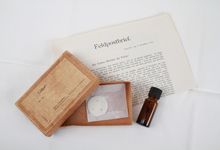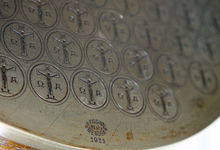The centenary of the communion wafer: the various forms over time
All Jesus said was to use bread and wine to celebrate His memory. But what about the bread? With or without leaven? Red wine or white wine or even grape juice? Christianity has many answers when it comes to the question of how Holy Communion should be celebrated.

At the very beginning it was a meal intended to still the disciples’ hunger: the Last Supper, which Jesus ate with His disciples. And while they were having supper Jesus performed this symbolic act: He broke the bread and passed the cup. And this is how the first Christians celebrated Holy Communion: the Lord’s Supper was celebrated in the context of a community meal. The first epistle to the Corinthians testifies of this. Over time, Holy Communion moved away from the meal to a celebratory act and became a sacrament within the framework of a divine service.
Dispute over leavened or unleavened
What kind of bread should be used? About a thousand years ago, this was the dispute between Latin-speaking Christians in Western Europe and Greek-speaking Christians in Eastern Europe.
The Catholic Church decided to use bread without any rising agent, with reference to the three Synoptic Gospels. According to them, Jesus celebrated the Last Supper on the evening before the Passover. And in this case, unleavened Seder bread was prescribed by the religious laws of the time—an unleavened flatbread, also called matzo.
The Orthodox Church insisted on leavened bread. They based this on the Gospel of John, according to which the Last Supper took place a day earlier, so that the prescriptions dictating Passover did not apply. Besides, Jesus Himself gave the parable of the leaven, comparing it to the kingdom of God.
War on the crumbs
These differences persist to this day right across the various denominations and even within certain denominations: reformed Protestants and united Protestants tend to use white bread made from dough with leaven. Lutheran Protestants, however, use unfermented wafers—as does the New Apostolic Church.
From the thin, unleavened flatbread called matzo it was only one small step to the wafers that we use today. The crisp sheets of matzo easily crumbled or broke. This was absolutely inacceptable from a theological point of view. After all, spiritually we are talking about the body of Christ. And this is certainly something that has to be treated with as much dignity as possible.
White wine stains less
When it came to wine, there were quite a few different positions too. But in this respect, the Catholic and Orthodox Churches agreed. It had to be real wine, not grape juice. But while the Eastern Church insisted on red wine, the Western Church also allowed white wine. The reason was of a practical nature: white wine stains the altar cloths less.
The Methodists, for example, and United and Reformed Churches prefer grape juice, and this is also an option in the Lutheran Church. Historically, this goes back to the deliberate renouncing of alcohol or the participation of children in Holy Communion. From a theological point of view, supporters justify this with reference to the Bible text: it does not explicitly state that it had to be fermented wine; all it talks about is the cup and the “fruit of the vine”.
Hygiene imposed by wafer
There are also various ways how the wine is served during the celebration of Holy Communion. In the Catholic Church it is traditionally mainly the Priest who drinks from the cup, while in the Protestant Church the cup with the wine is shared with the believers just like the bread is.
But having everyone drink from one and the same cup raised concerns about hygiene. There were several options: introducing small individual cups or dipping the consecrated wafer into the communal cup.
From there it was only a small step to the form that the New Apostolic Church has now been practising for exactly one hundred years: the wafer with three drops of wine.
Photo: stefania57 - stock.adobe.com
Article info
Author:
Date:
Keywords:
Andreas Rother
28.06.2017
Holy Communion,
Doctrinal statements,
Denominations








